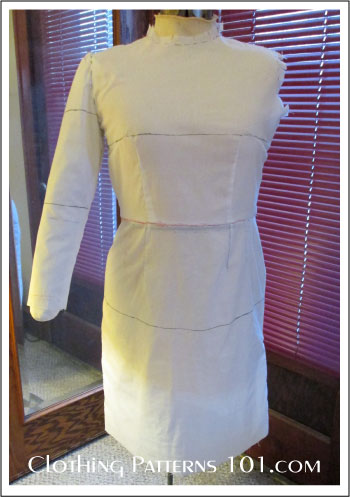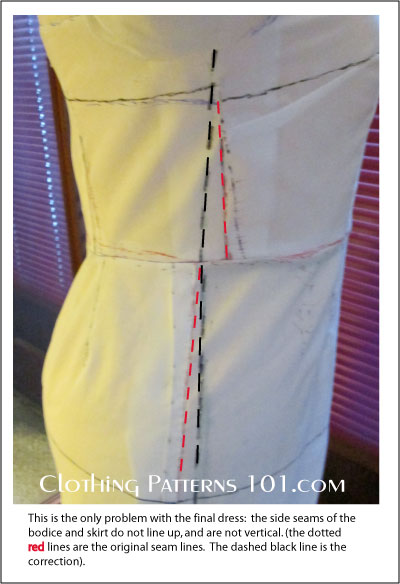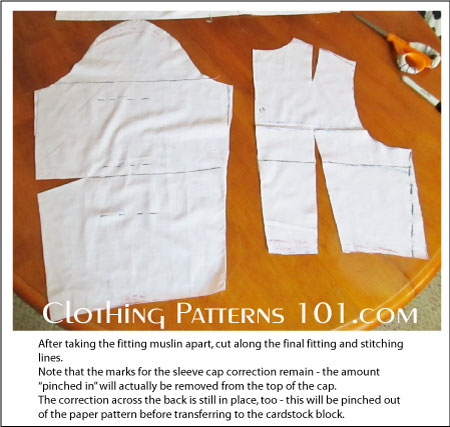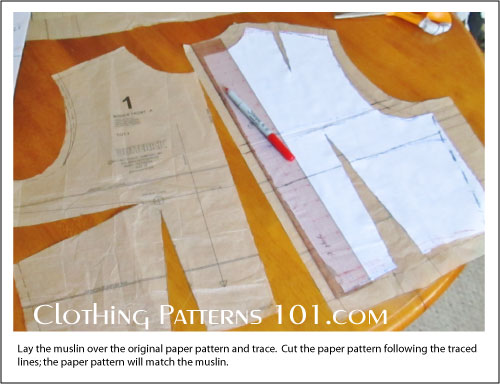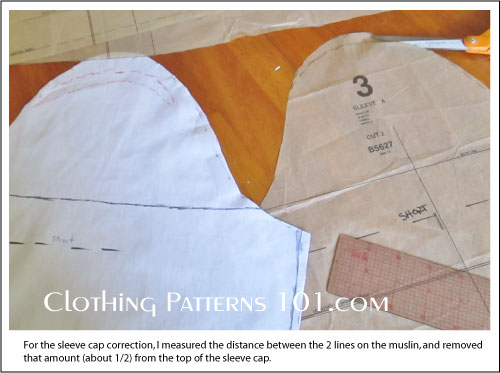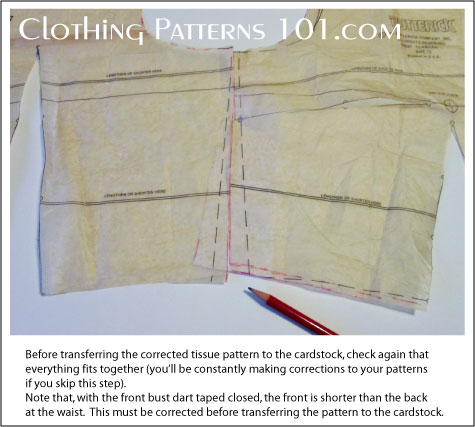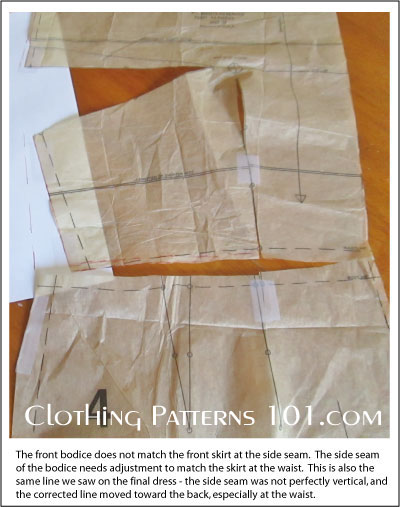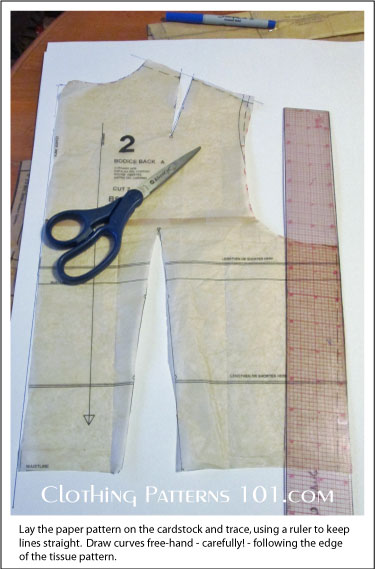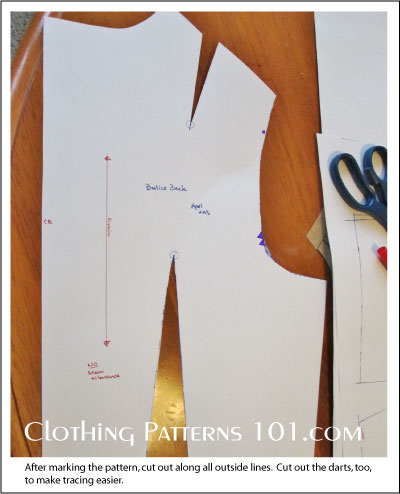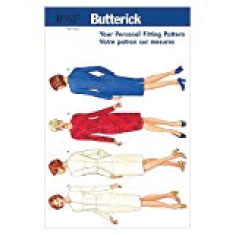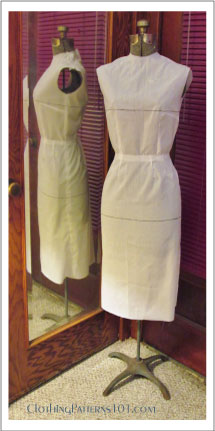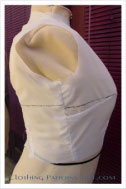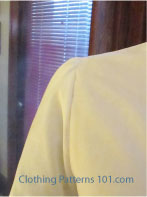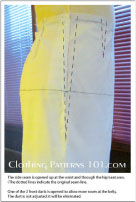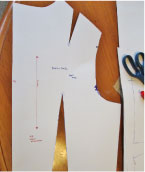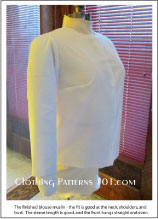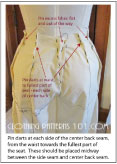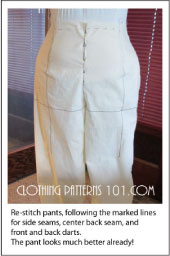- Clothing Patterns 101
- Making Your Personal Pattern Block
How to Make Your Personal Pattern Block
You're ready to make your pattern block!
Using the final fitted muslin, you'll transfer all of your corrections to paper, and then make a cardstock basic block pattern that you'll use again and again to create your new designs. And they'll fit! Hooray!
By now you have assembled your fitting muslin and fit it on yourself or on your body form.
This is my fitting pattern muslin. Overall, it fits the form pretty well.
Take another look to see if anything is still tight, droopy, or uneven. This is your last chance to fix it, so you'll never have to fix it again.
What I found on my dress, unfortunately, is that the side seams on the bodice and skirt did not line up properly, and overall the seam was was not straight.
The red lines indicate the seams as sewn on the final version of the dress. The black line is the corrected seam line. I will make these corrections as I transfer the markings to the paper pattern.
Transferring Your Corrections to the Tissue Pattern
First, take the muslin dress apart along the stitch lines (make sure all stitching lines are clearly marked before taking the dress apart).
Then, trim the pieces along the FINAL, corrected seam lines/dart lines. There should be NO seam allowance on these pieces.
On the sleeve cap, I did not cut the sleeve along the alteration line; I will make that adjustment to the paper pattern.
On the back, I pinned the bodice to shorten it; again, I will make the same folded adjustment to the paper pattern.
After trimming the muslin pieces, lay the muslin piece over the corresponding paper pattern and transfer all seam lines, darts, and other markings made during the fittings. Then trim the paper pattern, as you did the muslin pieces.
The photo at right shows the back bodice laid over the paper pattern (use a ruler to draw straight lines onto the paper pattern). The front bodice (on the left) has already been trimmed.
On the sleeve cap, I measured the distance between the marked lines where I pinched out the excess fullness.
I then removed the same amount (about 1/2") from the top of the sleeve cap on the paper pattern.
Before transferring the paper pattern to cardstock to make the pattern block, check that all the pieces fit together.
Tape any darts closed where they meet the seams you are checking. Here, I have taped the side bust dart closed to check the side seams. The waist darts can remain open at this point.
Lining up the front and back bodice at the side seam, I see that the sides are uneven at the waist. I'll add a piece of paper to the front bodice to correct the problem.
Using the same process, I've taped together the waist darts on the bodice and skirt patterns (releasing the bust dart so the pieces lay as flat as possible).
On the front, the bodice and skirt do not match at the waist. This is a reflection of the problem we saw when the final dress was on the form.
I need to add to the bodice side, mostly at the waist, and tapering to nothing at the armhole.To do this, I simply tape a piece of paper to the pattern and re-draw the line.
The black line on the dress photo, near the top of this page, indicates that the side seam of the bodice needed to be moved back. This is the resulting pattern correction.
Transferring Your Tissue Pattern to Cardstock
Once you've checked all of your pieces to make sure that the seams match and everything fits together, you can transfer the tissue pattern to cardstock for your re-useable pattern block.
Plain white (or light-colored) cardstock is available at craft stores, or the craft section of your sewing center.
Lay the tissue pattern on the cardstock and carefully trace it onto the cardstock. Use a ruler for straight lines and carefully draw curves free-hand (or use a curved ruler, if you'd like).
Do NOT add seam allowances. It is easier to add style lines when you design a new style when there are no seam allowances on the basic block. You'll add seam allowances to your final sewing pattern.
After tracing the tissue pattern onto cardstock, transfer all markings - dart lines, grain lines, notches, dots for marking ease placement, etc.
Also mark center front (CF) and center back (CB) on the bodice and skirt, and the shoulder point on the sleeve cap.
Finally, write the name of the pieced (such as "Bodice Back"), and any other information you think you will need as you work with the pattern.
I like to add the date (bodies change over time!), and sometimes other notes (such as "no seam allowance", just to remind me when I'm using the block!).
Finally, cut out the pattern piece, cutting out the darts as well as along the stitch lines. It is much easier to trace the pattern and place the darts when they are cut out of the pattern block.
Congratulations! You Have a Block Pattern!
Now the fun begins - you can design almost anything you want, and use the block pattern to create a sewing pattern for that style.
But first - there's one more block you might want to make.
What's the Next Step?
Personally, I seldom wear anything as fitted as the fitting dress (especially the bodice). So, for convenience in making blouses and tops, you can use your block pattern to make a torso or blouse/top block. It's essentially your introduction to using your block and manipulating it to make a new pattern.
Ready to start? Let's make a blouse block!
Need More Help with Fitting Issues?
The examples on this site reflect MY fitting issues and how I resolved them. Your body is likely very different.
But, since this is a site about the mechanics of making patterns and not specifically about fitting, I'm not going to address other fit issues here. And believe me, there are others who can address this issue better than me.
Any of the books listed below will help you achieve good fit. You can use the techniques on any pattern; but why make the same corrections over an over again? Apply the principles to your block, and the fit corrections YOU need will be automatically built in to every pattern you make!
I can recommend any of the following books and an online courses to help you achieve good fit, no matter what your size or shape. I own or have used almost all of the books on this list, and have been pleased with how they address fit problems.
And there are a couple that address plus sizes, too!
Click on the links below to go to the item in Amazon. As an Amazon Associate I earn from qualifying purchases. This helps to keep this site free for your use. You are free to search Amazon for these or other similar items without using the affiliate links on this page.
I am also an affiliate of Craftsy, and receive a small commission on their classes. I have taken several Craftsy classes, and highly recommend them. Click on the text links, below, to find the classes at the Craftsy site. You may need to become a member to access the classes.
- Pattern Fitting With Confidence - A very useful book written by the late Nancy Zieman, host of the TV series "Sewing with Nancy". She provides a straightforward, down-to-earth approach to sewing and fitting. Very user-friendly.
- The Complete Photo Guide to Perfect Fitting - I love this book!!! So wonderfully illustrated with photos, using commercial patterns to demonstrate the pattern alterations. It addresses almost any fit problem you might have. So easy to understand and follow!
-Sewing for Plus Sizes - Creating Clothes that Fit and Flatter - A great book for Plus sizes! As a woman gets larger, it's not just the measurements that change - our overall proportions shift, too. This book addresses the different body types and proportions you commonly see in larger women. Truly helpful for larger women.
- Fitting Solo from Measurements to Muslin - This class shows you how to take your own measuements (fundamental to creating your block), and then make adjustments to the pattern (make these changes to the FITTING pattern for a perfectly fitted block!). You will also make a muslin, as I have described in the block-making process. It's kind of like the instructions on this site, but with video demonstrations!- Pattern Alterations: Fixing Fit Issues - This course covers pattern alterations to correct a gaping neckline, sleeve issues (including fitting the bicep), and making adjustments to the abdomen and seat areas.
- Plus Size Pattern Fitting and Design - As a size 16 (and only 5'2" tall), I qualify as a Plus size. And I've taken this class with Barbara Deckert - it is FABULOUS! Aside from the fitting tips, she also explains the style lines and silhouettes that are flattering to the Plus size figure. I highly recommend this class!
